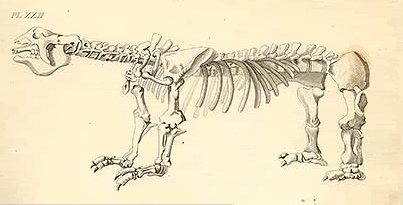Post by Barry the Baryonyx on Aug 26, 2007 14:14:32 GMT -5
Megatherium (Giant Ground Sloth)

Megatherium skeleton. From James Parkinson, "Organic Remains of a Former World", c.1830.
Megatheriinae were a subfamily of elephant-sized ground sloths that lived from 2 million to 8,000 years ago. Their smaller ground sloth cousins were the Mylodon.
Unlike its living relative, the tree sloth, Megatherium was one of the largest mammals to walk the Earth. Weighing almost as much as an African bull elephant, it had huge claws on its feet. These claws meant that it could not put its feet flat on the ground and so, like a modern anteater, it had to walk on the sides of its feet. Its footprints show that it walked mainly on its hind legs. When it stood on its hind legs, it was about twice the height of an elephant, or about twenty feet tall. They were one of the abundant Pleistocene megafauna - a wide variety of very large mammals that lived during the Pleistocene epoch.
Megatherium had a robust skeleton with a large pelvic girdle and a broad muscular tail. Its large size and specially adapted body made it possible to feed at heights otherwise unobtainable to other contemporary herbivores. Rising on its powerful hind legs and using its tail to form a tripod, Megatherium was able to support its massive body weight while using its long forelegs with curved claws to pull down branches with the choicest leaves. Its large deep jaw is believed to have housed a long tongue, as in the modern tree sloth, which it would then use to pull leaves into its mouth.
Some recent morpho-functional analysis (Bargo, 2001) indicate that M. americanum was well adapted for strong and mainly vertical biting. The teeth are extremely hypsodont and bilophodont, and the sagittal section of each loph is triangular with a sharp edge. This suggests that the teeth were used mainly for cutting, rather than grinding, and that hard and fibrous food was not the main dietary component.
There is a common misbelief that the sabre-toothed cat Smilodon hunted Megatherium, but the sloths were far too big for even this large cat to attack. Richard Fariña and Ernesto Blanco of the Universidad de la República in Montevideo have analysed a fossil skeleton of M. americanum and discovered that its olecranon—the part of the elbow to which the triceps muscle attaches—was very short. This adaptation is found in carnivores and optimises speed rather than strength. The researchers say this would have enabled M. americanum to use its claws aggressively, like daggers (Fariña and Blanco, 1996). The conclusion is that due to its nutrient-poor habitats, Megatherium may have actually taken over the kills of Smilodon. A number of adult glyptodon fossils have also been found where the shell was turned upside down. This hints at Megatherium scavenging or hunting this animal, as no other known animal existed in South America during that period that could flip an adult glyptodon.
It was formerly thought that Megatherium lived only in South America. However, a University of Florida research team recently found a skeleton in North America. This was a new species of giant sloth, which weighed nearly as much as an African bull elephant, more than 5 tons. Unlike previous discovered species, it had 5 digits and 4 claws instead of 4 digits and three claws.
Habits
Little is known about the giant ground sloth, but we do know that it was big and powerful. When it stood on its hind legs, it was about twice the height of an elephant. Its very thick skin, which was covered with dense, heavy fur, protected it from predators. The giant ground sloth was an herbivorous animal that fed mainly on plants that grew on the ground. Its believed that the giant sloth lived in groups, but it may have lived singly in caves.
Food & Feeding
The giant ground sloth lived in the lightly wooded area s of South America, feeding on the leaves such as yuccas, agaves, and grasses. Eremotherium, close relative of the sloth, lived in more tropical environments further north. Pulling itself upright to sit on its haunches or to stand, the giant ground sloth balanced its weight with its tail. It then tugged at plants with is feet, digging them up with the five sharp claws on each foot. The sloth used its simple teeth to grind down food before swallowing it, and its highly developed cheek muscles helped in this process. The sloth's stomach was able to digest coarse and fibrous food. For millions of years, the sloth had no enemies to bother it, so it was probably a day time feeder. It is likely that it spent a lot of time resting to aid digestion.
Copyright © 2007 Answers Corporation


 Is it just us?
Is it just us?